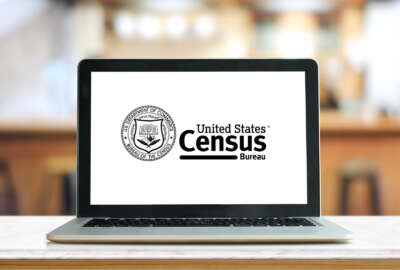
IBM lays out plan for a ‘digital society’
IBM has a history spanning the earliest mainframe computers to artificial intelligence and blockchain. Now it's published what it calls bold ideas for a digital...
Best listening experience is on Chrome, Firefox or Safari. Subscribe to Federal Drive’s daily audio interviews on Apple Podcasts or PodcastOne.
IBM, one of the original federal IT contractors, has a history spanning the earliest mainframe computers to artificial intelligence and blockchain. Now it’s published what it calls bold ideas for a digital society. Strategies that federal agencies can use to make sure their technology, and their services offerings, are always up to date. For more, Federal Drive with Tom Temin turned to IBM’s general manager for U.S. public and federal market, Jay Bellissimo.
Interview transcript:
Tom Temin: Mr. Bellissimo, good to have you one.
Jay Bellissimo: Good morning, Tom, thank you very much for the opportunity to spend time with you.
Tom Temin: Now, in the blog posts that IBM has put out, it mentions that large commercial organizations are taking certain steps to as you put it future proof their IT investments and their services, what are some of the ways they are doing it?
Jay Bellissimo: Tom, it provides all of us a great opportunity. Unfortunately, with the pandemic, it’s really stretched a lot of organizations, whether it be in the federal or on the commercial aspects of the environment here. And the common opportunity is that to stay pace with everything going on, especially again with the COVID impact, it’s going to be crucial for organizations and companies to really transform themselves and modernize both their infrastructure in the application. And we’ve seen many great examples, whether it be at Department of Homeland Security, or recently, some of our work at the Veterans Administration around benefits, there is a need, an urgent need to make sure that we keep pace with delivering those ultimate experiences to the citizens, as well as ensuring in the same breath that we ensure the critical operations of these mission critical applications.
Tom Temin: Well, again, you mentioned, some of the commercial organizations that are leading the way here, and what specific steps have they done or what for that matter has VA done to ensure this kind of delivery, especially when people need online more than ever?
Jay Bellissimo: Well, I think it starts first with just really reimagining the way work is going to get done. Again, with the impact of the pandemic, when you look across your core processes, such as claims processing, you really have to look at it through a different lens and traditionally. And so using the Veterans Administration example, we looked at the importance, the mission is to provide veterans with the quickest and speediest quality service we can. And we realized that a fair amount of the processes were very manual in terms of just receiving all the different requests in the mail. And so we use some automation, as well as artificial intelligence to help expedite and streamline it and move those resources that were focused on doing a lot of those mundane manual tasks initially, and elevate them to do higher level function tasks. So that really enabled us to look at that end to end process from when those claims arrive to processing it. Again, with the laser focus and ensuring that we amaze and delight the veterans as they receive the services. So that’s an example of reimagining the way work gets done, the way we did it traditionally isn’t necessarily the way it’s going to get done now. And then by infusing the technology like AI and automation combined with the data, it gave us a great opportunity to really be agile and deliver, I think, a very differentiated experience to the end citizen, in this case, the veterans.
Tom Temin: And the issue that you mentioned a moment ago of modernizing their legacy applications and infrastructure, especially on the application side — what does that mean? Because many times the legacy applications that were in so called old fashioned languages, actually are extremely optimal for the transactions and the types of processing they were designed to do. And so how can you add digital services say that are outward facing without wrecking what is, in some cases, magnificently executed logic that’s run for many years, that you still need to keep going on those traditional systems?
Jay Bellissimo: Well, it’s a great point, Tom. And the way we look at it is there’s the so called back office, there’s the middle office, and the front office, and whether it be VA or other organizations. And you may have already seen the letter our CEO Arvind Krishna had sent recently to the incoming Biden administration, we have a concept called tomorrow ready technology strategy. And there’s three key parts to that. The first is to adopt a hybrid cloud architecture. The second is to increase the adoption of commercial technology. And the third is to enhance the role of the CIOs in leading IT modernization decisions. And the reason why I start there, as you alluded to, there are a lot of systems that absolutely are so called optimized up until this point, and some of those will continue. But in some cases, you need to have cloud native applications. And it’s not so easy to modernize your infrastructure because some of these systems are 20-30-40 years old, and though they serve a function, you’re going to need to kind of migrate or modernize to this new way of doing business. I mentioned earlier, reimagining the way work gets done, whether it be in the supply chain customer service across these areas. So our view is that you need to look at the infrastructure, as well as the applications and they go hand in hand. So for an example, just because you maybe migrate your infrastructure, or modernize your infrastructure to the cloud, it doesn’t mean all your problems are fixed, that’s a great step in a move to do that. But what we’re really focused on is this hybrid cloud, which means, the average client or customer has between 6 to 12 clouds. So we want to be able to take the best of the best. So maybe some of those legacy applications are still critical, and you don’t need to change. But in a lot of cases, to really improve that experience with your customers, and in our case in the federal market to the citizens, it’s going to really take a modernization of those applications. So you want to be able to have an infrastructure that’s resilient, that’s agile, and gives you the opportunity to maybe run some of those core legacy systems on premise or on a mainframe. And in some cases, you might want to be able to move to developing cloud native applications so you can have the best of both worlds. And that’s really our focus is working with organizations in the federal government, as well as in the commercial sector to make sure that we’re providing that hybrid cloud architecture so you can be open and be able to have that flexibility to drive the innovation needed with that focus on the citizens.
Tom Temin: And what about the human factor in all of this, because very often you hear that well because we have these COBOL programs or these assembler programs, we can’t find the people to maintain them anymore, even though they actually do a better job at what they do sometimes in the modern languages. But on the other hand, Java is falling out of favor slowly but surely, and there are a whole generation of languages beyond that. So is a big part of this really keeping the people up to date and their skills up to date such that that’s how you really get to future proofing?
Jay Bellissimo: Yes, it’s so critically important, the topic of skills. And as you said, there’s kind of two aspects and there’s almost two ends of the continuum. One is, as you said, to provide those skills of a lot of those legacy environments. But the other part is all the new skills. You mentioned Java and just think of all the Python and other languages and capabilities and skills. Our view at IBM is it’s equally important. We continue to make huge investments in the communities you think about our pathway for technology, what we call P-Tech, because we think that we are millions of jobs short to be able to provide these new capabilities as we move forward. So on the one hand, as I mentioned earlier, automation gives us a great opportunity to help resources in skills to be retooled. So if you have a set of maybe experts in a certain technology by retooling them, you give an opportunity for them to maybe move into higher level functioning jobs. And then on the other side, there’s a lot of new skills, and you have a lot of the next generation workforce. And we believe resolutely that IBM as any company in our business, each of us are stewards to make sure we usher in this next generation of the workforce and provide the requisite skills and experience to make them successful. On the other side, we want to continue to work with organizations to help them retool and re skill their employees so that they can also be successful and thrive with some of these new technologies as we modernize both the infrastructure as well as the applications. And I would extend it to even the business processes. Think supply chain and finance, no longer can you be isolated. I think everyone’s going to have to have a decent understanding of how these technologies work and how they all come together with business processes, even more so than we’ve seen in the past.
Tom Temin: Earlier, we talked about artificial intelligence. And of course, presuming that’s not a flavor of the month type of technology. And I don’t think it is, I think pretty much there’s universal agreement that this is going to apply in a lot of areas. What are the essential skills needed to deal with artificial intelligence beyond people that can write algorithms?
Jay Bellissimo: Well, there’s gonna be a whole set of skills that are needed. I mean, in basic sense, we look at AI as being a partnership between man and machine. It’s looking at what are those capabilities needed to the earlier conversation we had about maybe automating and using AI to perform functions. When you think of how it’s being applied, we have 1000s of examples, and many, many use cases and how organizations have tapped into AI to really bring the value to these organizations. And a lot has happened over the last six years. I’ve been involved since 2014, and it’s really amazing when you look at the types of skills and functions. It’s not just the data scientists, it’s not just the in some cases the computer science majors so to speak, it’s impacting all aspects of an organization. When you look at the use cases for artificial intelligence, whether it be on maybe call centers or other use cases in supply chain or procurement, it’s really important for everyone to start to get exposed at varying levels of expertise. But it’s important for a whole organization because fundamentally, in my experiences, when I’ve seen AI be used very successfully, and has really created that value that companies seek, it’s when it’s not just again a subset of a technology organization, that’s absolutely critical, again, think data scientists and programmers, but it’s also the business analysts and other people in other functions, other resources, and maybe human resources, or finance or supply chain. So everyone has to have some level of understanding of AI. And it’s no longer a question is AI going to happen? Ai is here today. And it will continue to thrive and be used more and more. The point being is we all have a responsibility to understand it, irrespective of your function and your job role. But equally important as we move forward and as this AI technology is embedded more and more in our business processes. We also have a responsibility, all the different companies that are working with AI, to make sure that we have ethical standards and guidelines. And we work together across the globe to make sure that we are all ushering in this new era of AI in a very responsible way. What we call essentially building trust through precision regulation. And that simply means that, again, we all have that responsibility to create that oversight, to make sure that we ensure human oversight and bias testing of these AI systems as they’re involved more and more in high risk decision making.
Tom Temin: And earlier you mentioned that Chairman Krishna wrote to the Biden administration, incoming administration, with some advice. What would your advice down at the ground level be to whoever is the next federal CIO?
Jay Bellissimo: I would say there is never a good time to drive dramatic change. But to be frank, from my perspective, with everything that’s going on with the pandemic, I’ve worked with many federal organizations and state organizations as well as commercial companies, and obviously, we start by being empathetic, and making sure that the people in the communities we serve are taken care of, as well as our own families. But as we look to how we’re going to thrive in this new way of working in the new way of living, we all have that responsibility to make sure that we continue to work together. So my biggest advice to the administration is to continue to think about reimagining the way work is going to get done because there is a new normal, so we need to work together. And I think the biggest game changer for the federal government, the US federal government, is going to be ultimately around the hybrid cloud architecture. And making sure as we embrace the hybrid cloud architecture, we’re also increasing the rate and pace of the adoption of commercial technology. I mentioned earlier about AI, but this is going to be critical because we don’t modernize these infrastructures in these applications with a greater sense of urgency, I’m afraid we’re going to be stuck and we’re going to fall victim to moving too slowly. And I fear that we’re not going to be able to keep up. Obviously the pandemic has been gut wrenching for the last nine plus months. But there will be inevitably other crises around the corner. And the faster we can modernize our businesses and rethink the way work will get done and provides all that supporting infrastructure, both infrastructure technical, as well as the applications — I think it’s going to position us so well to continue to focus on providing those incredible experiences to our citizens, as well as ensuring that we keep our critical mission applications and functions up and running, and quite frankly, ahead of everybody else.
Tom Temin: Jay Bellissimo is general manager for the US public and federal market at IBM. Thanks so much for joining me.
Jay Bellissimo: Thank you very much. Appreciate the opportunity.
Copyright © 2025 Federal News Network. All rights reserved. This website is not intended for users located within the European Economic Area.
Tom Temin is host of the Federal Drive and has been providing insight on federal technology and management issues for more than 30 years.
Follow @tteminWFED





